Identifying Chicken of the Woods Mushroom
For the new mushroom hunter, Chicken of the Woods is one the easiest and most beginner friendly mushrooms to find.
This choice edible mushroom will quickly become a favorite that you’ll look for every time you head into the woods!
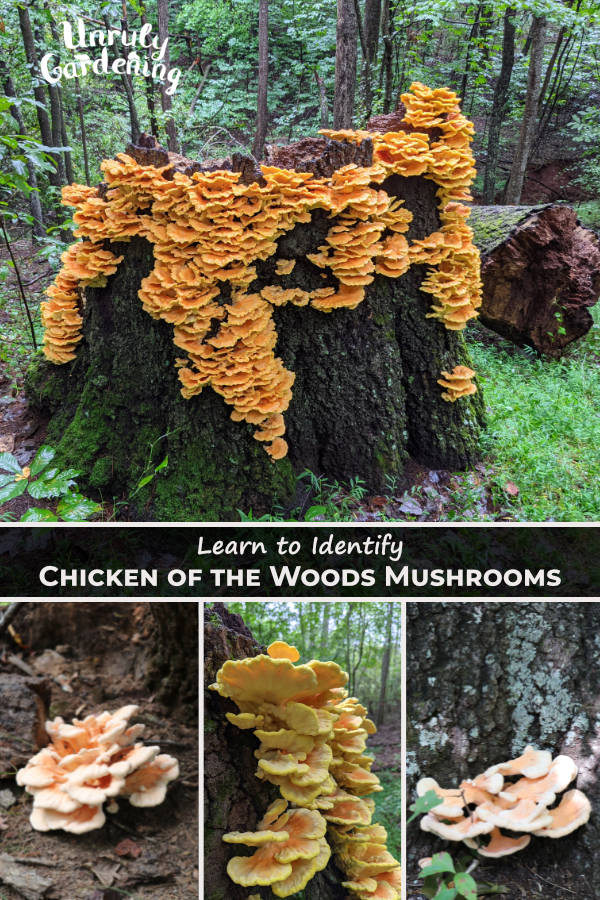
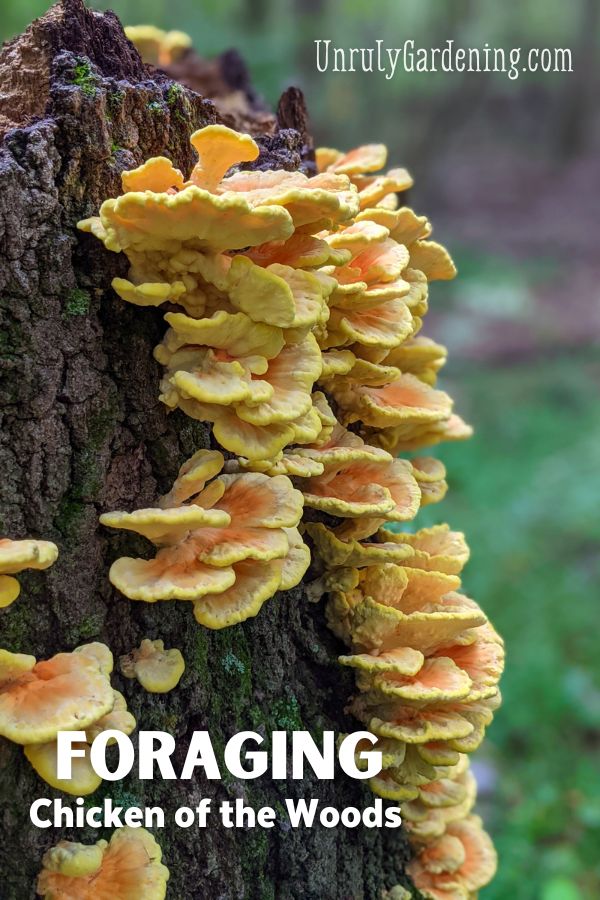
What is Chicken of the Woods?
Chicken of the Woods is a polypore mushroom – which means it has small pores on the underside, instead of gills.
It feeds off of and helps to decompose the wood of dead trees, so you’ll find it growing on dead trees, fallen logs, and stumps. You may sometimes find it on a live tree, where it acts as a parasite and causes their wood to rot.
There are many species of Chicken of the Woods in the Laetiporus genus, but today we’re going to discuss two species common to Eastern North America, Laetiporus sulphureus (sulfur shelf) and Laetiporus cincinnatus (white-pored sulfur shelf).

How to Identify Chicken of the Woods
When identifying Laetiporus sulphureus and Laetiporus cincinnatus the first thing to note is what kind of tree it’s growing on, as these are most commonly associated with oaks, but can sometimes be found on other hardwood trees.
If you find Chicken of the Woods on conifer trees (fir, spruce, and hemlock trees) it’s a species known as Laetiporus conifericola. While still edible, some (but not all) foragers think that it’s more likely to cause digestive issues. We haven’t found or tried chicken mushroom growing on pines, so can’t personally comment on that!

Sulfur Shelf (orange & yellow)
Laetiporus sulphureus (sulfur shelf) has a bright orange to orange-red or orange-yellow upper surface that’s smooth or slightly wrinkled. The edges are usually bright yellow and wavy. The caps are about 2 to 12 inches (5 to 30 cm) across, semi-circular to fan shaped, and occur in overlapping clusters, which can lead to extremely large fruiting bodies.
When it comes to a stem, there isn’t one, or there’s a pseudo (“false”) stem , which is actually a part of the caps. This part can be tough, so you don’t usually cook it.
Flip a piece over and you’ll see the bottom, or pore-bearing surface, is a bright, sulfurous yellow, with very small pores. The spore color is white, but it can be difficult to get a spore print since it sometimes ejects the spores right after cutting.

White Pored Sulfur Shelf (peach & white)
Laetiporus cincinnatus (white-pored sulfur shelf) is somewhat similar in appearance but has a pale pinkish to pale peachy or salmon colored upper surface, a white pore-bearing surface underneath, and only occurs at the base of a tree (primarily oaks).
It too has overlapping, individual fan-shaped caps that are about 2 to 10 inches (5 to 25 cm) wide that form a rosette of sorts.
White pored sulfur shelf is somewhat harder to find than the yellow sulfur variety, and is considered a choice edible.

Potential Mix-ups & Lookalikes for Chicken of the Woods

TOXIC LOOK ALIKE
Jack-O-Lantern Mushroom
While there are no direct look-alikes for the chicken of the woods mushroom, one that might be confused by beginning mushroom hunters is the jack-o’-lantern mushroom (Omphalotus olearius).
While this mushroom is orange and grows on decaying wood, it has very distinct gills on the underside. It will not have a smooth finely pored surface underneath. It is also bio-luminescent and subtly glows in the dark.
Jack O’ Lantern mushrooms will give you extreme digestive upset if you eat them, but it’s okay to pick one up and examine it closer, or bring it home to see if it softly glows in a dark room.

Hen of the Woods versus Chicken of the Woods
A mushroom that’s occasionally mixed up with chicken of the woods is Grifola frondosa, also called Hen of the Woods, or maitake mushroom.
It’s not because the two mushrooms look a lot alike though!

Hen of the woods is brown to gray, not orange, peach, or yellow, and has a different overall look, as you can see from the photo above. However, because of their poultry related names, they can sometimes be confusing to beginner foragers.
Black Staining Polypore (“Rooster of the Woods”)
Then there’s the black staining polypore (Meripilus sumstinei) which has the occasional nickname of “Rooster of the Woods”.

This mushroom isn’t yellow, peach, or orange either, but it’s a polypore (has small dots underneath instead of gills) with a similar fan shaped caps, so is sometimes confused for a pale, old, or over-grown chicken of the woods.
Black Staining Polypore is found at the base of oaks and other hardwood trees, often in clusters. It can grow to a HUGE size, but mostly only the tender young tips are used for cooking, and the rest used to make a yummy mushroom broth.
A most interesting feature of Meripilus sumstinei is that is will bruise and turn black where it’s been torn or damaged – which is how it got the label of black staining polypore!
Finding and Harvesting Chicken of the Woods
Chicken of the Woods is most likely to be found from August through October, but it can be found as early as May and up to December depending on where you live.
A nice thing about this mushroom is that it’s not particularly rain dependent. Even if we have a very dry summer, we’re still sure to find some nice specimens to harvest.
The large size and bright color make the Laetiporus sulphureus (sulfur shelf) easy to spot in the woods. It often produces in quantities enough so you can eat some fresh, and also preserve for later, by freezing or drying.
Once located, this mushroom will tend to return year after year, until it has used up its food source.
When collecting, make sure the mushrooms appear fresh and firm. As they age, they dry and lighten in color, becoming tough and riddled with bugs and worms. At this stage, usually the only area worth eating will be on the outer 1 to 2 inches.

On the right – A basket of freshly harvested Laetiporus cincinnatus.
Preparation & Preserving Chicken of the Woods
It’s best (and more easy to digest) to eat chicken of the woods when they’re young and juicy. Older specimens are usually bug riddled and less appealing.
Just like you’d do with any other new-to-you wild food, if you’ve never eaten this mushroom before, eat a small portion and wait 24 to 48 hours to see if you have a reaction.
Because it’s so delicious, it’s easy to eat too much in one sitting, and that might cause some upset stomach. Enjoy in moderation!
Store your fresh mushrooms in a brown paper bag in your fridge for about 2 to 4 days. Before cooking; give the mushroom a smell – it should smell faintly earthy, or may have no discernable smell. If it has a strong or unpleasant odor, discard instead of eating.
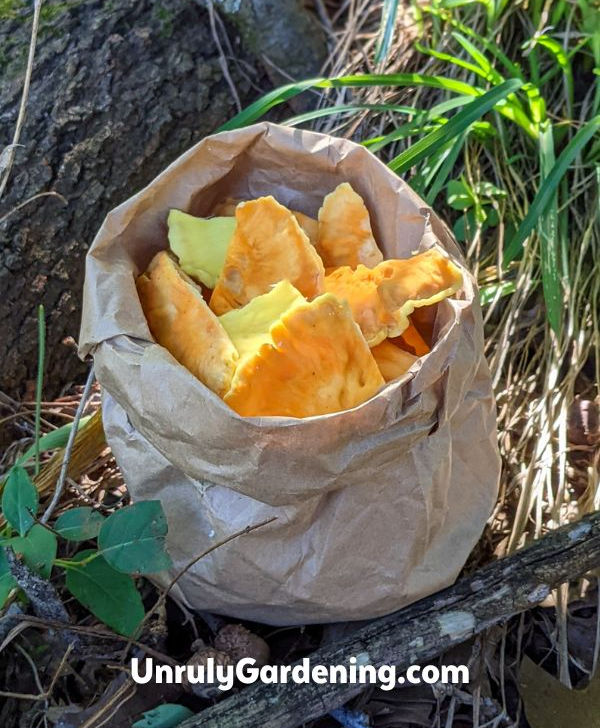
Video: Slideshow Summary of Chicken of the Woods ID Tips & Photos
Here’s a slideshow summarizing this article with photos and ID tips, for those who learn best with video. (Sometimes an ad plays first, but the video will start right after. The video player won’t show up if you have an adblocker.)
How to Clean Chicken of the Woods
Now that you’ve found some chicken of the woods, here’s how to clean it!
- Take your time and trim away any tough or bug eaten pieces.
- Brush off as much dirt as possible with a mushroom brush or slightly damp cloth.
- Give a quick rinse to remove any left over dirt or foreign material.
- Immediately blot dry with a paper towel.
If you’re going to eat them within 2 to 4 days, place the mushroom pieces into a brown paper bag and place in your refrigerator vegetable drawer.
Chicken mushroom has a meaty taste and is often used to replace chicken, lobster, or crab in recipes. Try using chicken of the woods in your favorite crab cake recipe, or chicken nugget recipe!

Looking for another recipe idea for cooking chicken of the woods?
Try out our family favorite – Garlic Butter Chicken of the Woods Mushrooms recipe!
Freezing Chicken of the Woods
Cut the mushroom into small 1/2 inch slices. Arrange on a baking sheet lined with parchment or freezer paper and freeze the individual slice before putting into a freezer bag.
Alternatively, chop up the mushroom, and sauté the pieces in a little butter or oil. Let cool and place in freezer bags in usable portions.
When using either of these methods, there’s no need to thaw before use. Just place directly in a skillet or pot and they’ll quickly thaw while cooking.

Dehydrating Chicken of the Woods
It’s not as ideal to dry chicken of the woods, compared to other methods of preservation, but the pieces can work when added to soups and stews.
To dehydrate, cut thin 1/4 to 1/2 inch strips of mushroom, arrange in the dehydrator with space around each piece. Dehydrate at 110 degrees F for 10 hours. Check every so often as they dry. If they’re not quite dry after 10 hours, then reduce the heat to 100 degrees F and continue drying and checking until they’re completely dry.
While not ideal for sautéing, dehydrated mushrooms can be used in long cooking dishes such as soups, stews, and broths. Just add the mushroom pieces directly to the dish and the juices will reconstitute the mushrooms and add flavor at the same time.
Dried chicken of the woods can also be powdered using a mortar and pestle, or small coffee grinder. It can then be used as a seasoning for various dishes that will be heated and cooked. (Don’t eat mushroom powder raw though – it’s not very digestible!)
Some people have an adverse reaction to chicken of the woods mushroom. A small percentage experience nausea, swollen lips, and gastrointestinal distress, or allergic reactions. It’s important to use caution and try just a little bit of the mushroom the first time and see how it makes you feel before consuming a lot.

More Mushroom & Foraging Articles
Enjoy foraging mushrooms and other plants? We do too!
Here are some more articles you may enjoy:
(Plus check our “Forage” tab to explore even more plants and mushrooms!)
All About Ghost Pipe (Monotropa uniflora)
Foraging Usnea Sustainably (+uses & recipes!)
12 Tips for Foraging Morel Mushrooms
Growing & Foraging for Mullein (Plus Harvesting & Preserving tips!)
Foraging & Using Reishi Mushrooms
Foraging Chanterelle Mushrooms
Foraging Goldenrod (Photos, Tips & Lookalikes!)
Our articles are for information and idea-sharing only. While we aim for 100% accuracy, it is solely up to the reader to provide proper identification. Be sure to seek out local foraging classes and plant walks, and invest in mushroom and foraging guides suitable for the area you live in, since some wild foods are poisonous, or may have adverse effect.
Sources & Further Reading
Elliot, Todd F. & Stephenson, Steven L. Mushrooms of the Southeast. Timber Press, 2018. Print.
Lincoff, Gary. The Complete Mushroom Hunter. Quarto Publishing Group USA, 2017. Print.

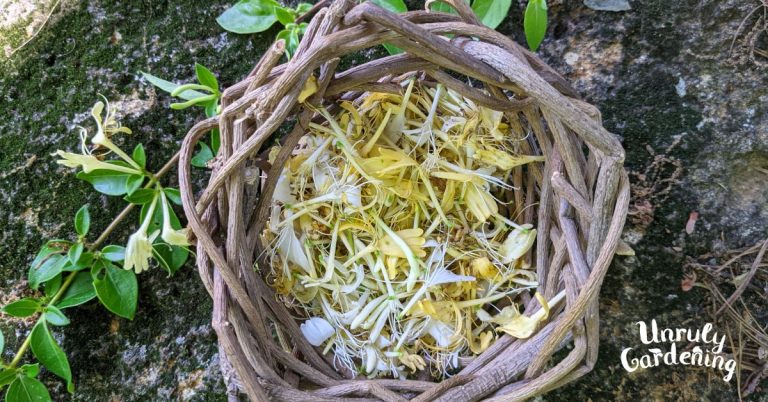
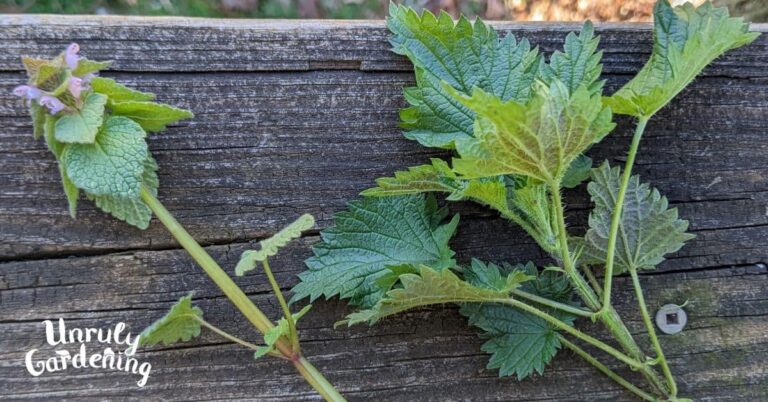
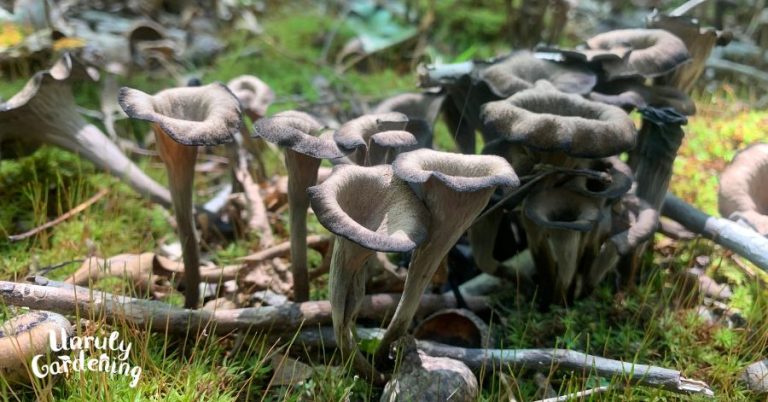
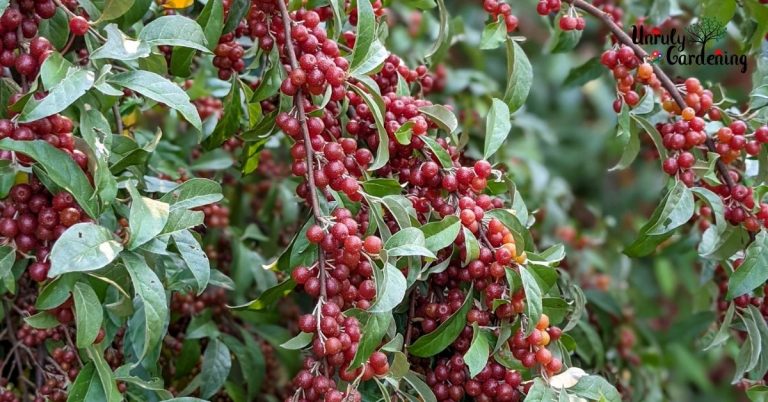

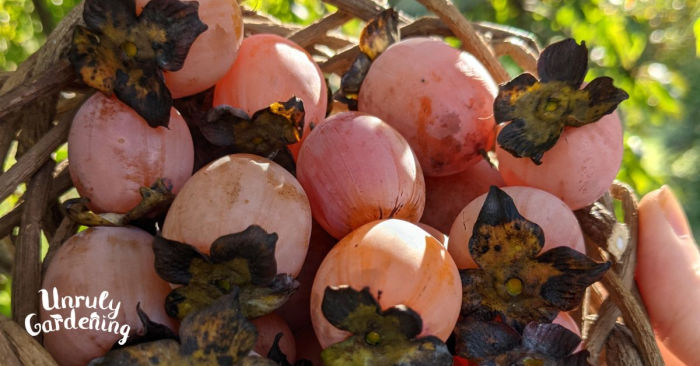
Very well done…good article.
Hi Henry, Thanks for the kind feedback – we’re glad you enjoyed the article!
Thank you for providing information on the Laetiporus cincinnatus variety. I found quite a huge one while hiking and brought enough back to fill 3 gallon freezer bags (after cleaning and cutting into 1/2 inch pieces), but as it was my first I wanted to be 100% certain it was COTW since it was more cream and peach colored (rather than the yellow) and growing from the ground. I’m definitely going to check out the recipe you’ve posted. Hopefully it’ll go well in quiche. 🙂
Hi Diana, I’m so glad the information was helpful & how wonderful to find such a haul of chicken of the woods to enjoy!
I found some at the base of an oak tree in my back yard
I’m trying to wait to see how big it grows it’s only about 4 inches wide and I’m hoping it grows a little bigger before cutting it out
Should I leave some in the tree still so that it will grow again?
Thank you
Hi Keenya, What a great find in your own back yard! You can cut the entire mushroom – the mycelium network underneath will allow it to keep growing, so you may find it again in the same spot (or really close nearby) the next year, and often even after that!
We do leave a little edge on the tree though, just so you don’t get bits of bark and dirt mixed into your mushroom bag/basket. 🙂
Thanks for the information! This definitely helps me in identifying some things I found and as a noob to the hobby I found your article very helpful!
Hi Laura, I’m so glad the information on Chicken of the Woods was helpful!
Happy mushroom hunting! 🙂
Hello! I found what I believe to be White pore sulfur shelf. The underside is a supple light green. I have looked at many pictures and read a bunch on differing versions of chicken of the woods. I am fairly sure I have the WPSS and will try a little tomorrow. Here’s looking at ya! Jimcorkee
Hi Jim! I’m not sure about eating a chicken of the woods with green on it.
I wonder if it’s turning old and that’s why you’re seeing that.
Are you on Facebook?
If so, I would check with local-to-you mushroom groups on there – upload a photo & see what group members say about the ID and age.
The group I’m in (for Virginia): https://www.facebook.com/groups/159509970892209/
is quite helpful, so hopefully there’s one for your state/area as well!
Thank you for sharing! I appreciate the tips for what to look for and where, and how to best harvest. I recently took two big pieces of chicken of the woods and made a “chicken” piccata with it. As a vegetarian it was a very pleasant and “meaty” alternative to chicken!
Hi Sheny, That sounds delicious! So glad you found the information helpful!
Really good article, thanks. Just found a huge one, downside is I got it from a Eucalyptus tree. I read it wasn’t good to eat from evergreens like Yew and Eucalyptus.
Hi Frazer, We’re so happy you found the article helpful!
Hello, l found something that looks like this mushroom but the edges are smooth and rond rather than thinner and wavy. Also it has gills and the colour is kind of chestnut but it was growing on a huge dead tree in a park nearby. Is there other lookalikes for this mushroom or is it another species altogether? Thank you so much for the article it is very useful. Cheers. Cate
Hi Cate! So happy the article was useful! Did you happen to take photos of the mushroom? If so, then I’d definitely check out a Facebook mushroom group for the area you live in & post the photos & see what the group has to say.
That can help point you in the right direction, then you can research guides from there & make sure the features match up.
My first thought was perhaps Gilled polypore (Trametes betulina), but that’s a random wild guess without photos to go by. 🙂
Hi. I found these in my backyard last week. They popped up overnight in our cultivated green lawn…many clusters of them. Is this normal for them to pop up like this? I live in Central Florida. There had been no rain. Never seen them before. Thanks.
Hi Marcia! Are you on Facebook? If so, I would post photos to your local mushroom group to make sure you have chicken of the woods.
They’re not likely to grow in the middle of a cultivated green lawn in clusters, unless you have some tree roots there too.
Chicken of the woods also tend to start a little small then slowly grow bigger.
That sounds possibly like you might be seeing Jack O’ Lanterns which are toxic.
If you flip a piece upside down, do you see a rather smooth looking surface with little pores or pin dots?
If you see gills (they look like little pleats or folds), then they aren’t chicken of the woods.
Definitely double check with several other people, groups & books before consuming these mushrooms, just to make sure you have the right ones! 🙂
I have what I think is chicken of the woods growing at the base of a sick japanese plum tree. it is light salmon pink colored. Any way someone can confirm this for me if I provide and photo?
Hi Sarah, What an exciting find!
Are you on Facebook?
If so, my first suggestion would be to find the mushroom foraging group for your state.
Those are usually very helpful if you post photos & they best know what kinds of mushrooms are in season in your locality.
For example – for where I live, we don’t often see chicken of the woods this early in the year, but it may be more common if you live in a warmer climate than us.
Or you might very well have an early bird growing!
Make sure you take clear photos of the top and bottom of the mushroom to help them ID it better.
If they’re not able to help, let me know and we’ll find more ID help for you!
I found a beautiful bunch of chicken of the woods on a trail and didn’t figure out what a treasure it was until a couple weeks later. Went back and found it again but tragically it was not fresh enough for consumption anymore. I brought some home in the hopes that maybe I could set it around an old wood pile and an old tree stump in my yard and it might release spores and grow. Do you think that is possible?
Hi Sandra! Unfortunately, it doesn’t work that way to inoculate a new area with an old mushroom.
You could grow your own chicken of the woods at home though – here’s some instructions from Field & Forest: (One of the places we buy mushroom spawn from.)
https://www.fieldforest.net/product/chicken-of-the-woods-on-logs-instruction-sheet/instruction-sheets
Hopefully next year, you can find more chicken of the woods back in the same area and get to enjoy some fresh!